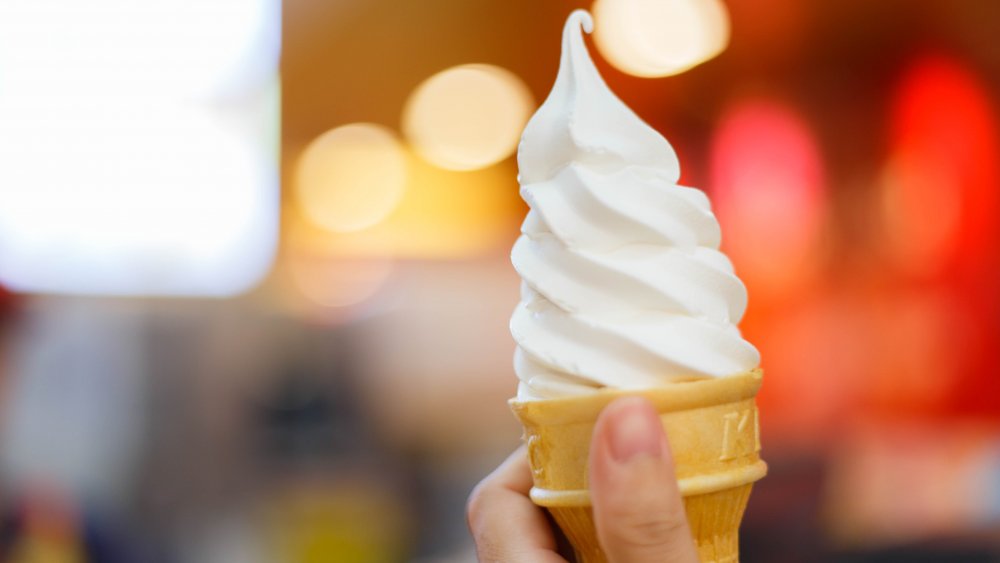Here's The Difference Between Chick-Fil-A Ice Cream And Regular Ice Cream
There's more to love at Chick-fil-A besides the fast-casual chain's famous chicken sandwich, chicken nuggets, or a cold glass of their signature lemonade. If you've ever tried Chick-fil-A's take on ice cream, then you know it's a deliciously creamy soft serve. The chain's soft serve is also used in almost all of its sweet treats including the different flavors of milkshakes, the frosted lemonade, and even the frosted coffee drink (via Chick-fil-A).
But you may have noticed that it didn't taste quite the same as normal ice cream. You would be right too because the chain's ice cream is actually called "Icedream" thanks to the kind of ingredients Chick-fil-A uses to make the soft serve (via Eat This, Not That!). However, it might be the light texture and mild vanilla flavor that make it so versatile in the chain's other frozen sweet too. To understand why Chick-fil-A's soft serve isn't really ice cream, you need to know what constitutes real ice cream.
Real ice cream has to meet certain FDA standards
There are certain standards ice cream has to meet to be called ice cream. Most frozen treats resembling ice cream are made with sugar, cream, and milk. Both ice cream and Chick-fil-A's "Icedream" contain these basic ingredients. However, there's another "ingredient," or lack thereof, that determines the status of real ice cream.
The amount of air that is in ice cream can significantly improve the taste of ice cream, though it is regulated by the FDA. The amount of air that is in the ice cream is known as overrun. So, a low overrun ice cream has little air incorporated in while high overrun has a lot. The less air there is in the ice cream, the more space there is for butterfat, which is why premium brands taste so good (via Reader's Digest). This also accounts for low-calories pints that allow you to eat the whole container without feeling too guilty. Those brands simply have high overruns.
The key here is that a low overrun is vital to allow the ice cream to hold more butterfat. When there's more butterfat in the ice cream, it tastes richer and creamier. This is the one thing that Chick-fil-A's "Icedream" lacks.
Chick-fil-A's Icedream isn't ice cream because of the ingredients
The truth about Chick-fil-A's ice cream is that it doesn't have enough fat to actually be called ice cream. In turn, this is the primary difference between "Icedream" and real ice cream. According to the restaurant's website, "Icedream" is made with nonfat milk and milk fat. So, the ice cream doesn't have any cream at all and very little fat overall. A lower fat content in the "Icedream" does make it a healthier, lower-calorie option, however. Not to mention, Chick-fil-A's Icedream cone was one of the most popular items ordered in 2019, according to the chain's blog, The Chicken Wire.
So while the soft-serve frozen dairy dessert is very similar to ice cream, it does lack that richness that comes with higher fat content ice creams. Though the overrun, or the air content of the ice cream, is unknown, it seems reasonable to think it's likely higher since the dessert has so much less fat to the point that it cannot be called ice cream. However, the amount of air is likely responsible for the decadent texture.
More fat isn't always better, though
Similar to controlling how much air is in ice cream, the FDA also controls how much or how little butterfat ice cream can have to be considered real ice cream. While Chick-fil-A's frozen dairy dessert falls below the mark, other ice creams can only have up to 20 percent butterfat. Honestly, you probably don't want more than that, though, because the fat will start to coat your mouth, giving it a filmy feeling (via Eater).
While we cannot know with certainty, it seems unlikely most fast-food restaurants use much butterfat in their ice cream or ice cream-adjacent products because butterfat drives the cost up. Wendy's famous Frosty, for example, uses less butterfat than ice cream. A former Wendy's exec cited "customer demand" as the reason. But butterfat is usually the most expensive ingredient in ice cream, so reducing or cutting it out altogether helps increase a chain's bottom line. If they do use butterfat, then you'll certainly pay for it. That's why premium ice creams tend to be so expensive.
So the next time you visit Chick-fil-A, enjoy a guilt-free cone. It will only set you back 120 calories, according to the company's website, and that's a great thing for anyone watching their diet. Don't forget that your child might even be able to score a free "Icedream" cone if they exchange their meal's toy.



